Many of these trees were my friends!
By Al R. Young
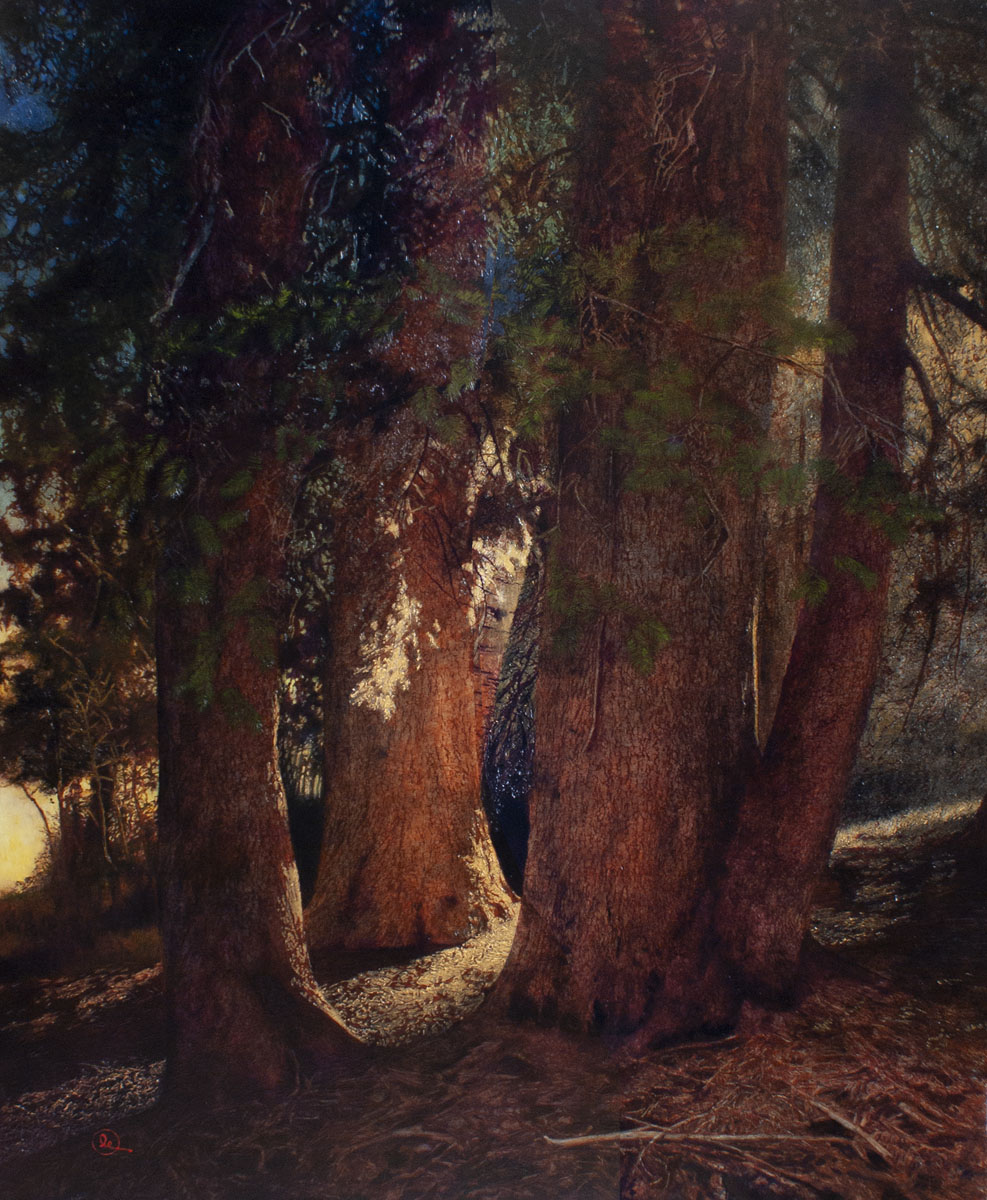 |
| Trailhead by Al R. Young |
dimensions (unframed width x height)
47 in. x 60 in.
support
Panel
milestones
Painting completed — 2021 July
Wildfire devastates the Nebo area — 2018 September
Begins color work — 2016 July
Monochromatic imprimatura completed — 2015 May
Embarks on another imprimatura, on the same ground, using Burnt Sienna — 2015 January
Scrapes away all imprimatura done to date — 2015 January
Discovers that the imprimatura is not bonding with the ground — 2015 January
Experiments with using pottery shapers (rubber wedges) to paint miniatures — 2014 December
Discovers that insect infestation has destroyed the Nebo trailhead — 2012 June
Visits trailhead for another photo shoot, to obtain high-resolution photos — 2012 June
Embarks on painting composition — 2012 February
Takes referent photograph during visit to Nebo trailhead in the Wasatch Mountains — 2003 October
Based on regular entries in the project journal for this painting, creation of the artwork involved approximately 147 painting sessions (from composition and panel preparation to completion of brushwork).
equipment created or modified for this project
New style of studio crate used to house panels during painting
costumes, miniatures, and props created for this project
None.
methodology
This section presents only one or two items that may be of interest to professional artists, amateurs, and others interested in the work of the Studios.
While the remainder of this page talks about the genesis of this particular painting and some of the problems encountered enroute to its completion, the following articles also comment on this painting:
Snapshot of an artist's workflowfrom the project history
Alberti's veil and the Tao of art
From the time the children were very young, Saturdays often found us hiking in the mountains. One of our favorite places—to which we returned repeatedly even after the children were grown—was the Nebo Trailhead at 9,100 ft. (elevation) in the Wasatch Mountains of north central Utah. Sometimes we hiked along the trails. Sometimes we could spare only a moment to walk just far enough under the eave of the forest to feel its welcome and renew our friendship with trees who remembered when the mountains were planted.
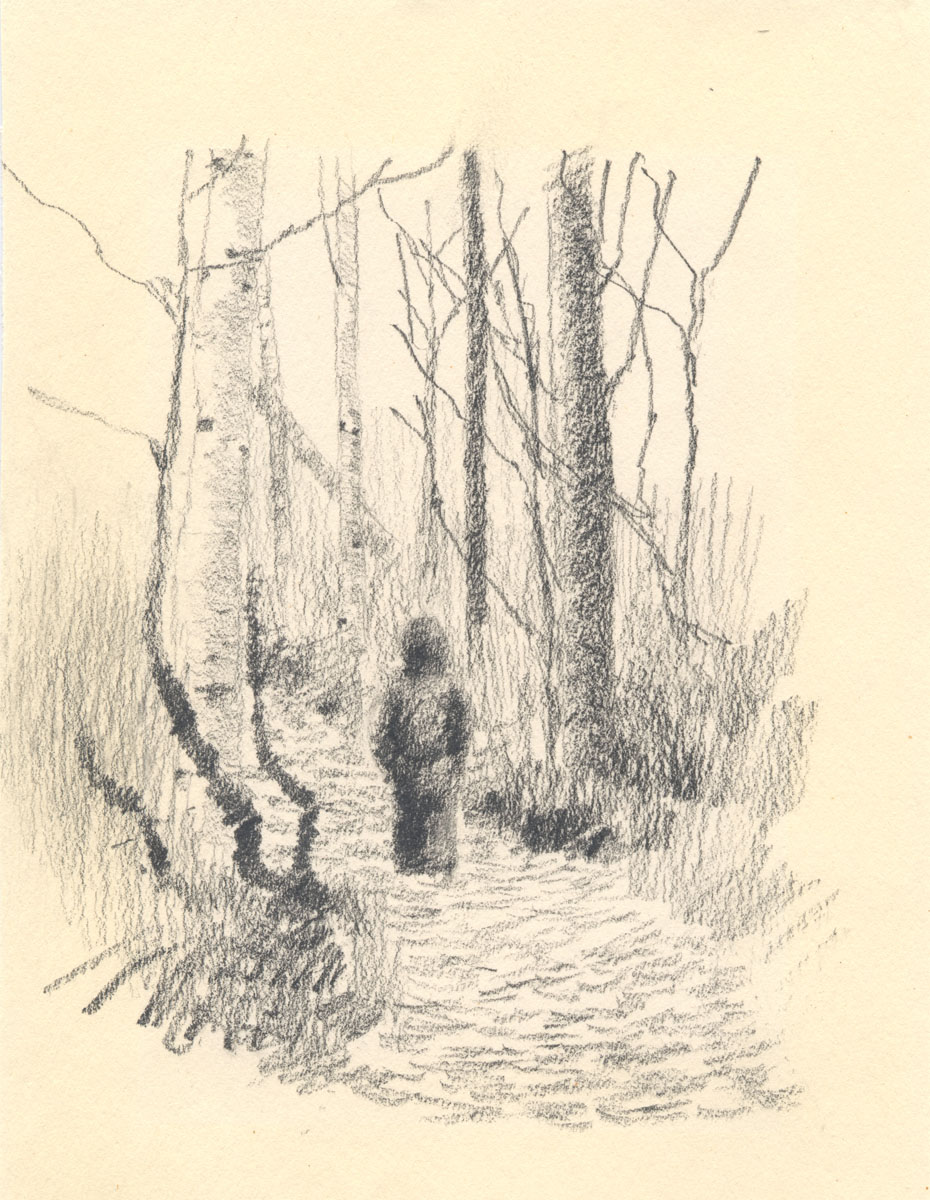 |
| Ashton Ahead on the Trail by Al R. Young Pencil on paper, circa 1994 |
The courage to commence
The gap, in the foregoing list of milestones (above) between 2003 and 2012, was occasioned by many things, not the least of which was my apprehension about tackling the subject. When a patron shows up with a commission, one's readiness may need to be expedited, but this painting was not commissioned. I was at my leisure to decide when I felt ready to embark, and thus I added reticence to other factors that inevitably dictate studio timelines. Even so, I never lost sight of this particular subject and my keen desire to express how I felt about it. During that waiting, I was greatly encouraged by the artistry of Ivan Shishkin.
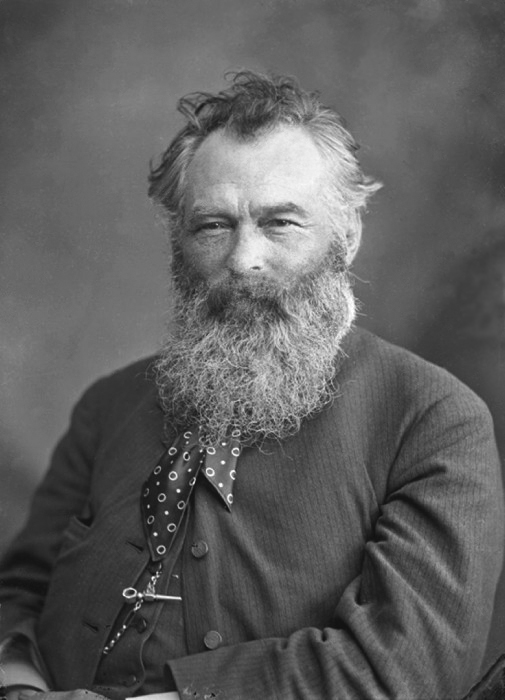 |
| Ivan Shishkin (1832-1898) |
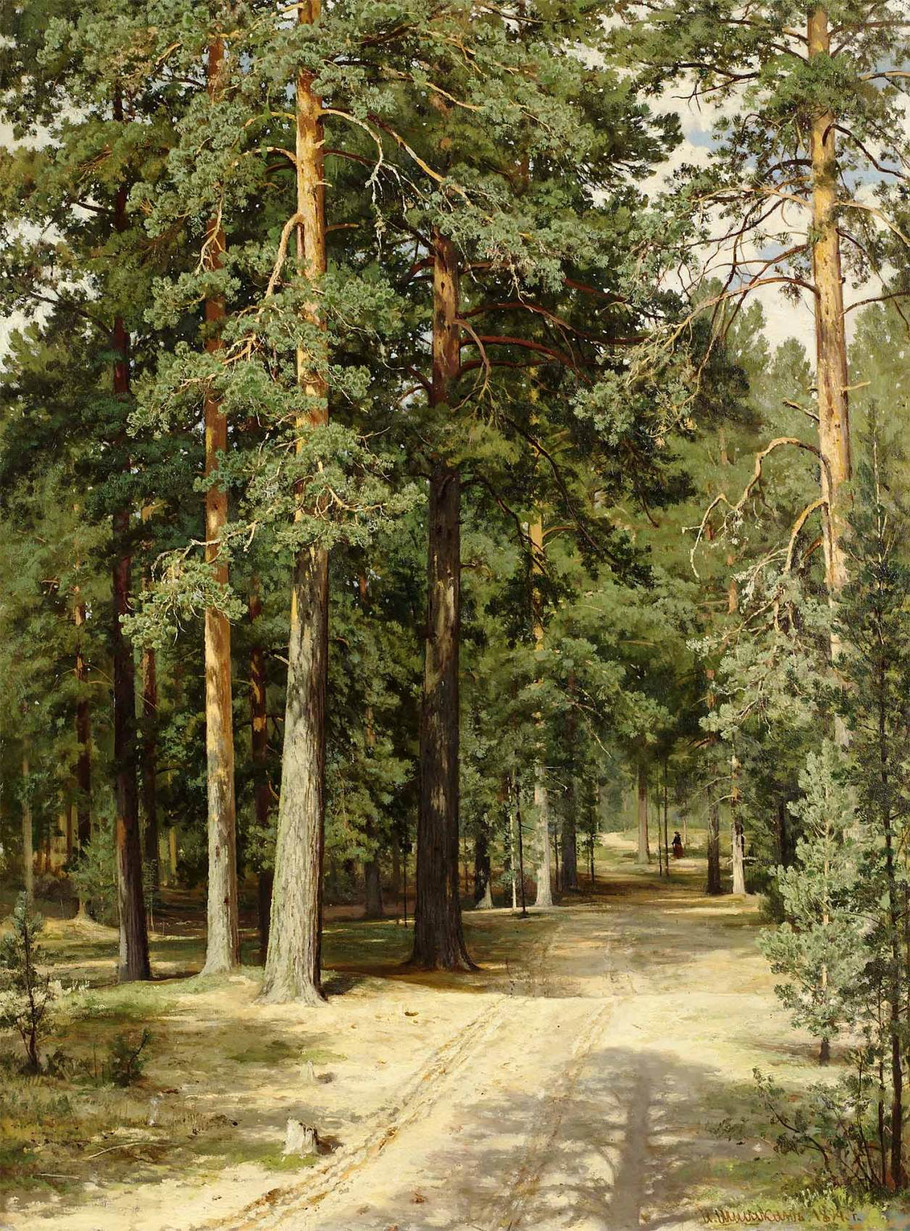
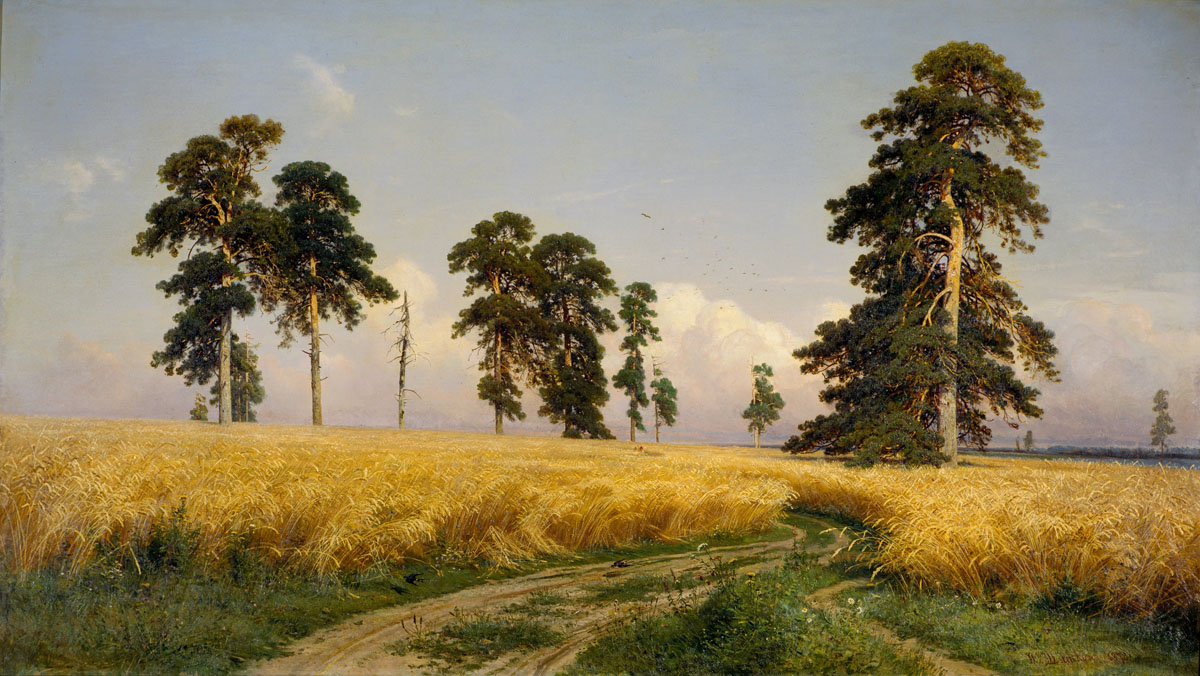
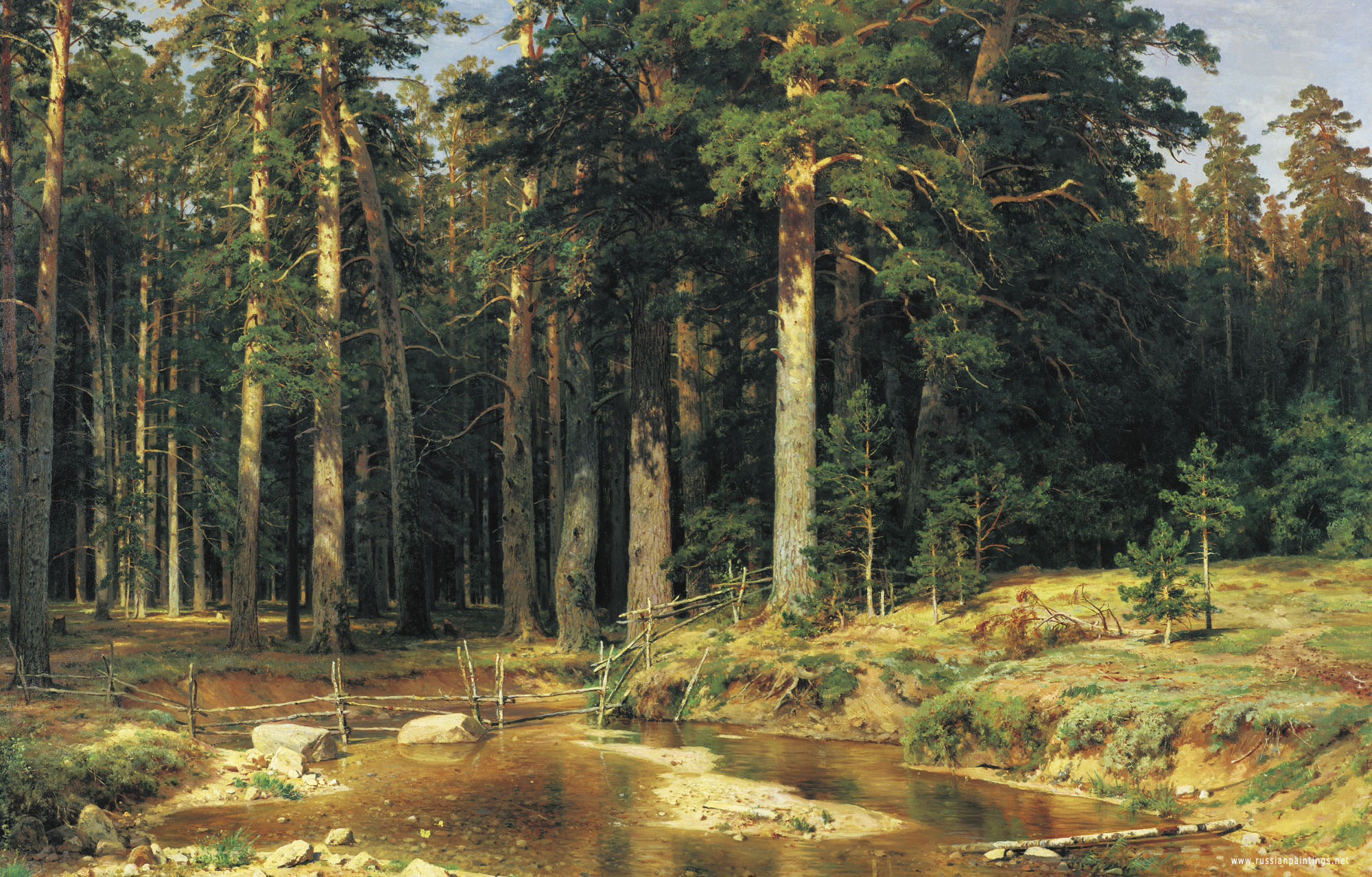
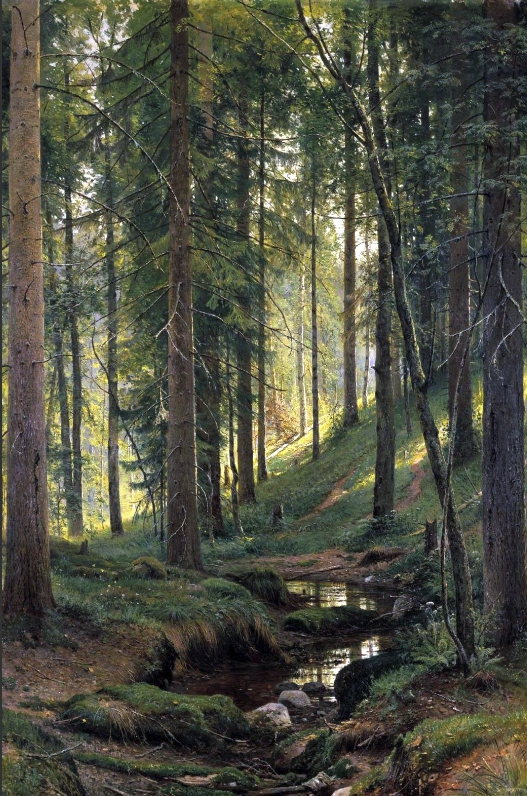
Resolve is galvanized
I began composing and planning my approach to the subject early in 2012, but decided it would be worth taking a much better digital camera back to the trailhead and shooting a much higher resolution photo than had been possible nine years earlier. Waiting for winter snows to melt and other circumstances to permit a visit to the trailhead at an elevation of 9100-ft., it was June before Elspeth and I turned off the Scenic Byway and pulled into the trailhead parking lot. The following photo is only a small part of a sight that took our breath away.
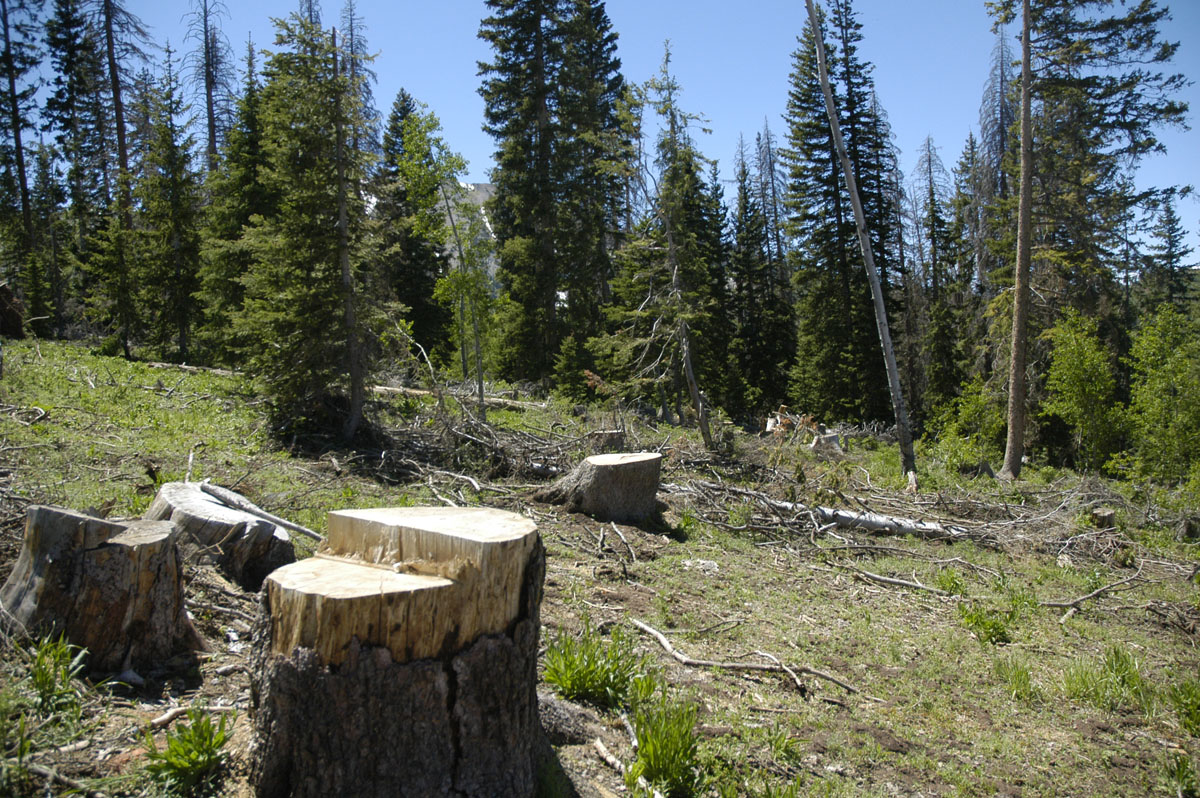 |
| Rampant insect infestation in the wilderness area had necessitated removal of many of the trees. We quickly verified that the particular monarchs featured in the photo were gone. We searched for other possibilities, but only much younger trees remained. Feeling a great deal like Treebeard upon discovering the spoliation perpetrated by the orcs of Isengard, Elspeth and I returned home. |
Disheartened but not dissuaded, I decided to cast my lot with the small-ish photo as reference, notwithstanding the great disparity between the small photo and its low resolution, and the huge scale at which I proposed to render the image. For various reasons, brushwork did not begin until the fall of 2014, whereupon I worked on the original imprimatura while that year drew toward its close.
A change in technique
During this time, I began experimenting with the use of rubber "shapers" used by ceramicists. I had used painting knives now and again for many years, but the wedges, as I like to call them, allowed me more control, tended to affect smaller areas of a painting, and did not always obscure the tool's point of contact with the painting (i.e., I could more readily see what I was doing). Nevertheless, the wedges have not replaced painting knives in my technique. Both tools still have their uses.
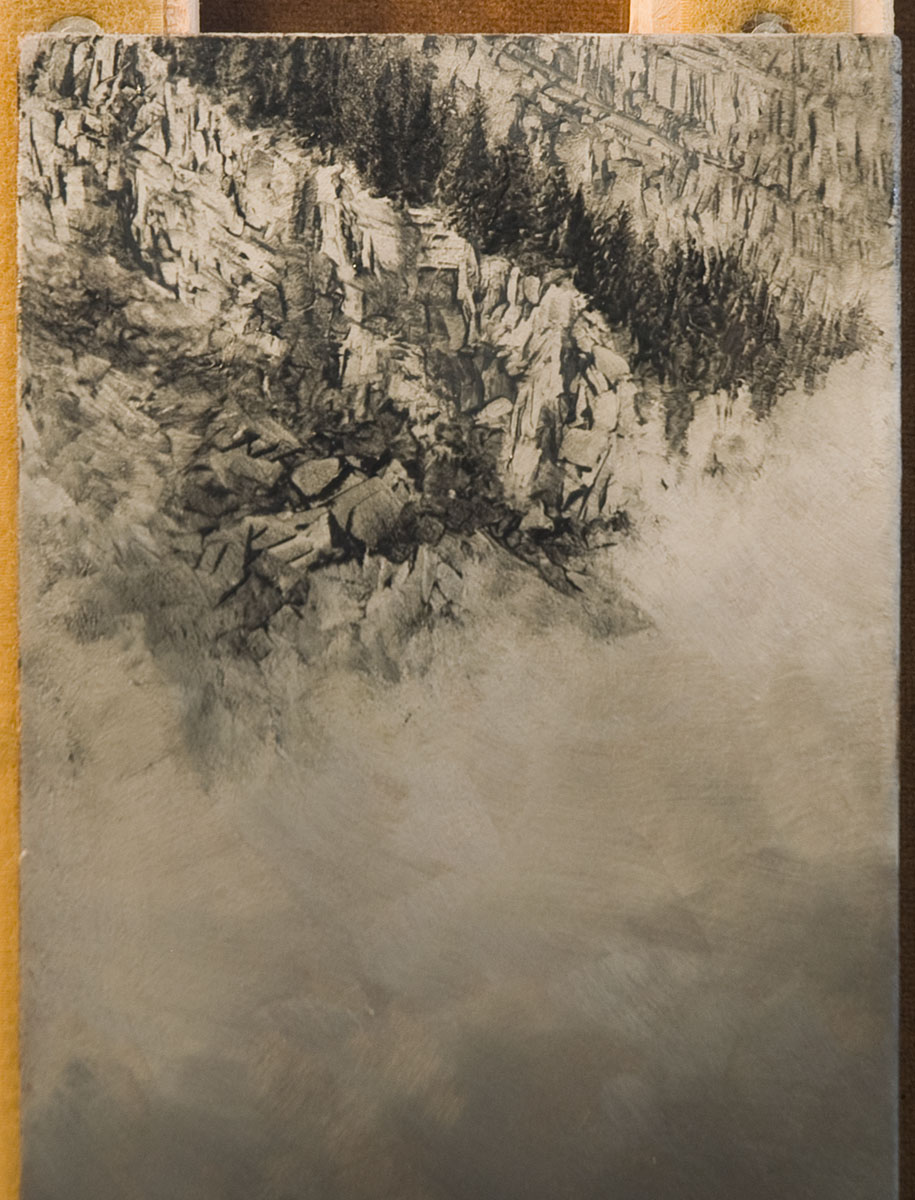 |
| This detail from a miniature panel (5 in. wide) was an early experiment with a wedge. As it turned out, the entire monochromatic imprimatura of Trailhead was achieved exclusively with wedges. |
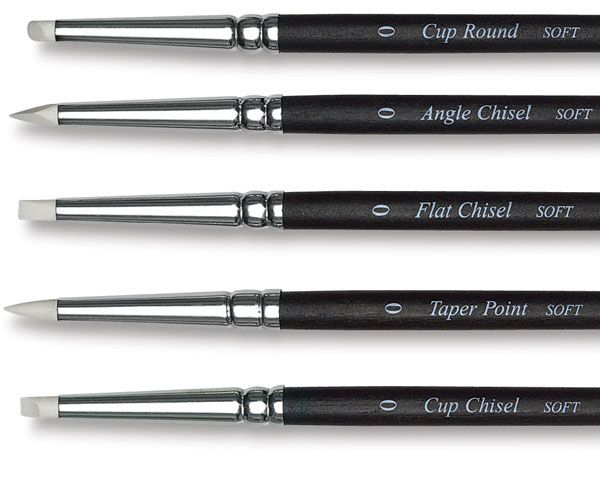 |
| A set of rubber shapers |
My primary reason for exploring possibilities associated with using wedges to apply and push paint around, instead of using brushes, had to do with one of the longest-lived conundrums of my work as an artist: Balancing the energy and kinesthetics of the act of painting with the emotions motivating the activity in the first place. Closely related to this is the balance between articulation and summary in the image itself into a personally pleasing balance, as well as a balance between planning and serendipity in the creation of a painting. This is a complex subject which exerts a profound influence on the artist; nevertheless, I will say only that the wedges were important in helping me move forward in major ways along that thread of my personal journey as an artist.
A disheartening problem
In the first weeks of 2015, with about 25 percent of the imprimatura done, I discovered that the imprimatura was not bonding with the tinted ground. My time-proven methodology for creating the ground (i.e., Masonite panel, sanding, hand-layered applications of water-based gesso, tinting with Raw Umber (applied by hand and without turpentine or any other medium or solvent), then applying an initial color layer intended for the sky) was what it had been for years. And with those layers of gesso dry, I was attempting to ghost-in the trees in a Green oil paint. The problem had to be the pigment.
Nothing could resolve the problem except removing the imprimatura, which I did by scraping it away. With that removal completed, I prepared to embark upon another monochromatic imprimatura, this time using Burnt Sienna straight from the tube. Burnt Sienna, being an earth tone, is a thirsty, fast-drying pigment that can actually dry by the end of a day's painting session. Like other earth-tone pigments, it can be mixed with other pigments to serve primarily as a siccative, if nothing else.
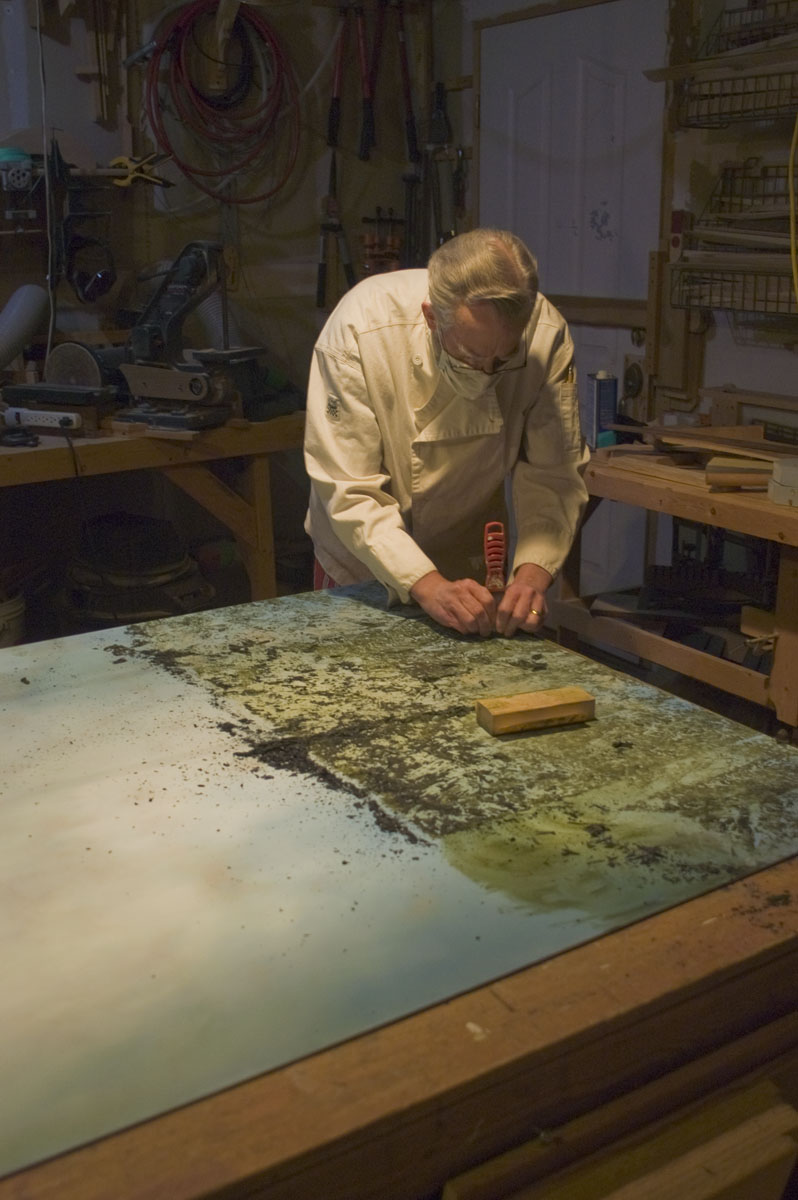 |
| Masked and bespectacled, I am in our woodworking shop scraping away the imprimatura. Holding the putty knife vertically gave me maximum control of the blade while attempting to avoid gouging the surface of the ground. |
The imprimatura
I embarked on the second imprimatura in January 2015 and completed it by May of that year. The imprimatura was done as a grid painting. See Alberti's veil and the Tao of art for detail. The project history for Trailhead records that by 2015 May 23 (when I finished the imprimatura), I had logged 35 painting sessions devoted to the Burnt Sienna imprimatura, and had completed the hand painting of 213 grid cells.
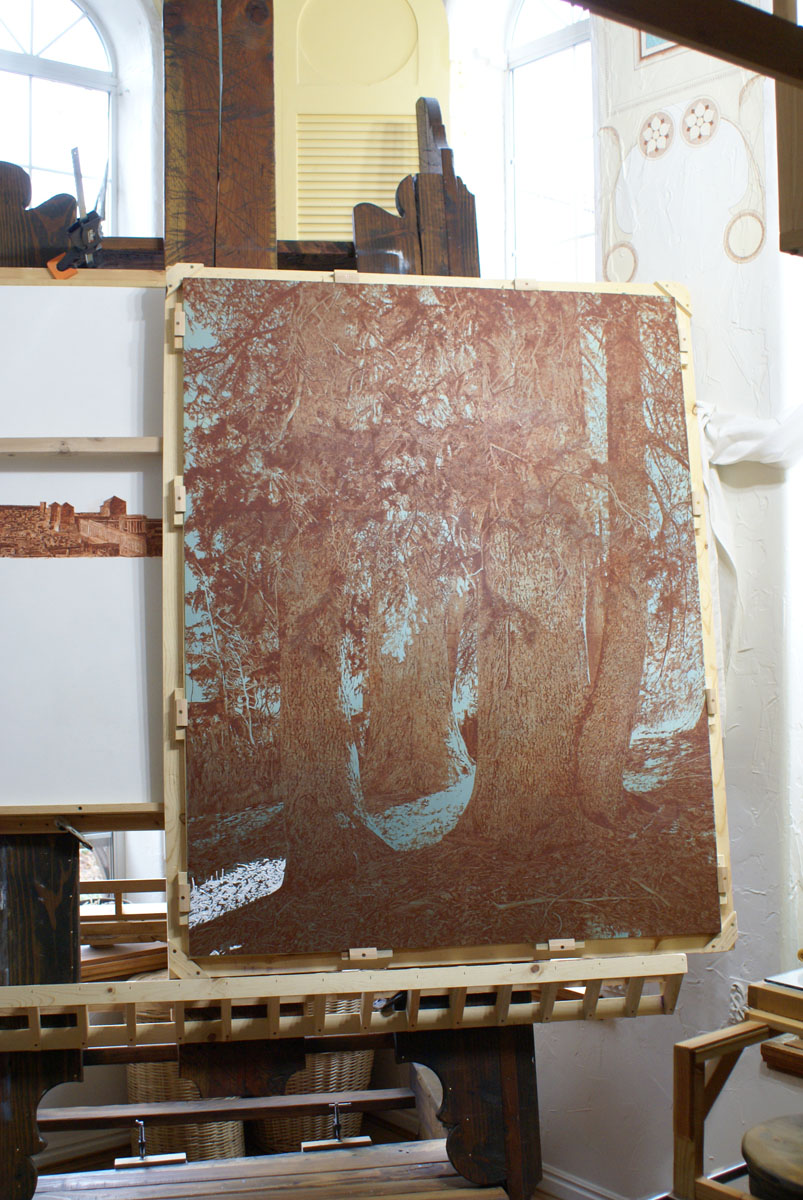 |
| This is one of the only photographs we have of the completed Burnt Sienna imprimatura. Note that the white highlights painted into the imprimatura (lower left) were added after the imprimatura was completed. Also, the imprimatura (in progress) for Rending the Veil appears behind Trailhead on the easel. |
While I used wedges to paint the imprimatura, I sometimes painted the positive space by using the wedge to apply paint to the panel. However, I also sometimes used the wedge to remove paint. For example, the debris field at the bottom of the image, consisting largely of innumerable pieces of limbs was much easier to paint by applying a solid layer of brown paint to a cell (in the grid) and using the wedge to achieve the "positive spaces" in the image by scraping brown paint away. It is my impression that what constitutes positive and negative space is a matter of personal preference that can change depending upon individual taste. Sometimes, while rendering an image, I see negative space as positive and positive space as negative. So, I am always painting the positive space; it is what I see as positive space that changes, depending upon which strikes me as being easier—at any given time or subject—to conceive of as what I am "applying" to the panel by means of the tool in my hand.
Finishing the imprimatura is a major milestone in any painting. Doing so, however, is one of those points in the creation of a painting that requires breaking or ruining the painting in order to move forward. I have very strong tendencies toward tonal work; in fact, I naturally paint tonally. Consequently, whenever I get to this point in a painting project, particularly when I have spent as much time and effort on the imprimatura as I did with Trailhead, I am usually so enthralled by the imprimatura that it is difficult, emotionally, to "ruin it" by applying glazes, not all of which (in my case) are transparent.
In addition to everything else about the project that had already been challenging, I realized too late that I had made a mistake in applying the entire imprimatura over blue because the contrast range in the imprimatura was far less than it should have been. The only thing to do was to correct the error by painting-out the blue in most but not all of the underpainting.
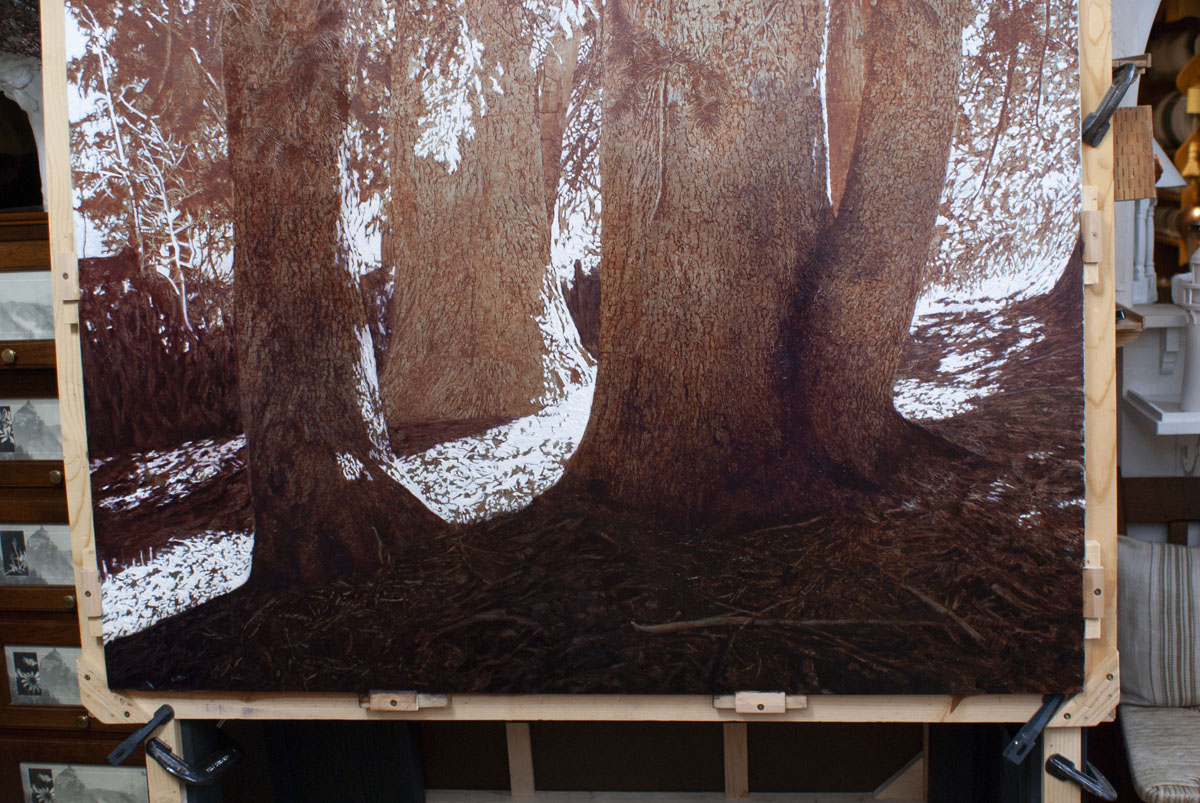 |
| Repainting so much of the imprimatura was tedious work indeed, but necessary. Planning can preclude a problem like this, but I find it more important to keep an open mind about such things because planning overmuch can preclude creativity. There is more to the story of this particular painting than there is space, here, to tell. Perhaps the most important thing to remark, here, is that every project is a journey, and I find it profoundly important to defer judgment in such matters until apparent problems have been dealt with; otherwise, it is too easy to inhabit a frame of mind that precludes discovery and creativity. |
It is thought that there are two distinct mindsets in terms of creativity: One discovers by making and then coming to understand what has been made, the other sees a vision and then sets out to make or re-create the vision. The former is vulnerable to quitting because of needed stamina for not knowing what one is doing or when the journey is apt to end, nor yet what the end will look like. The latter is vulnerable to despair because the artifact created seldom measures up to the vison or pre-conception. I am primarily, though not exclusively, of the former inclination or pre-disposition. (See Creation Myths by Marie-Louise von Franz, pp. 66-72.)
Glazing commences
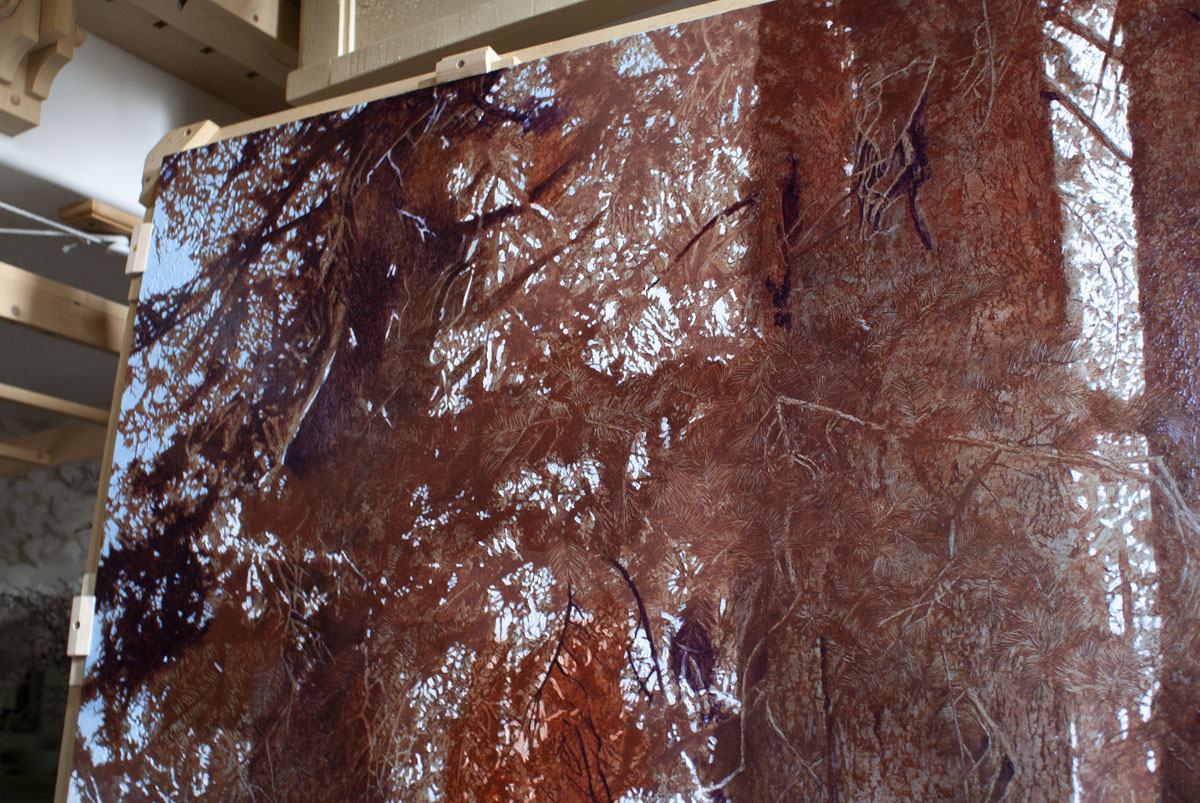 |
| Glazing commenced in 2018 August. |
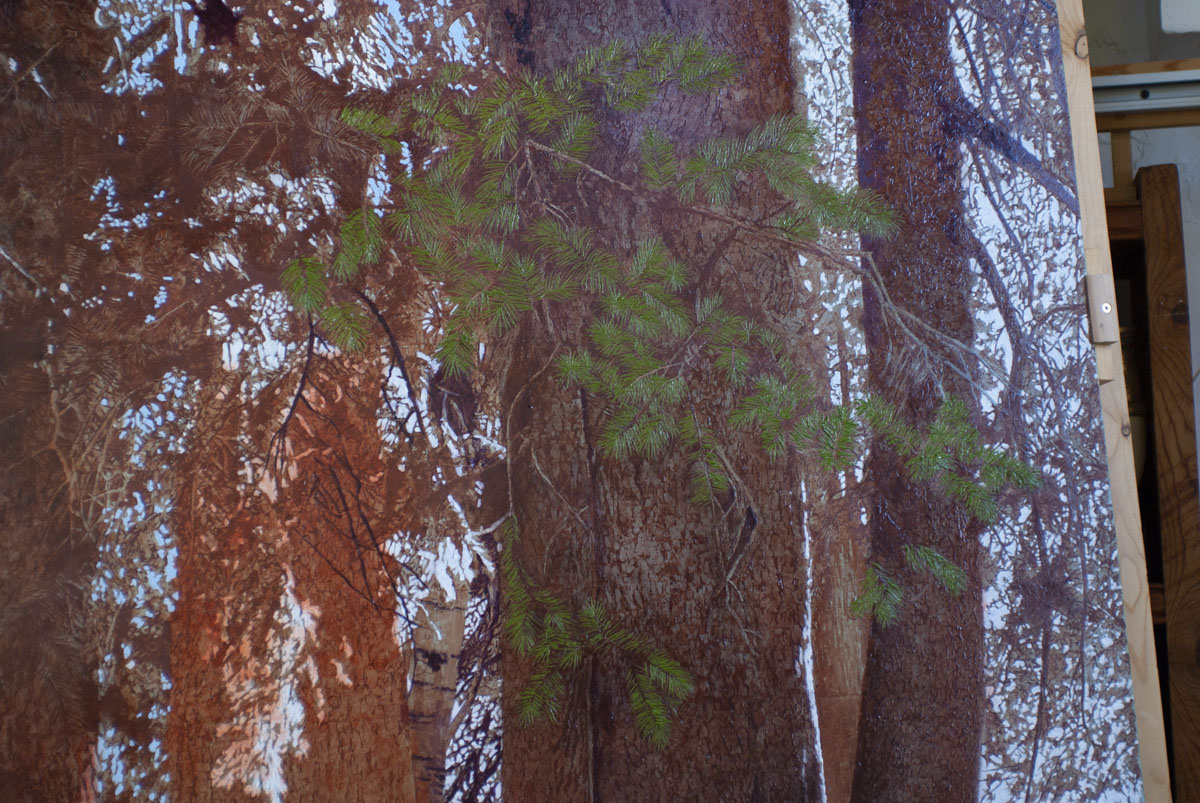 |
| During this phase, I also painted (ala prima) foreground needles on several foreshortened branches. |
Another disaster befalls the subject of the painting
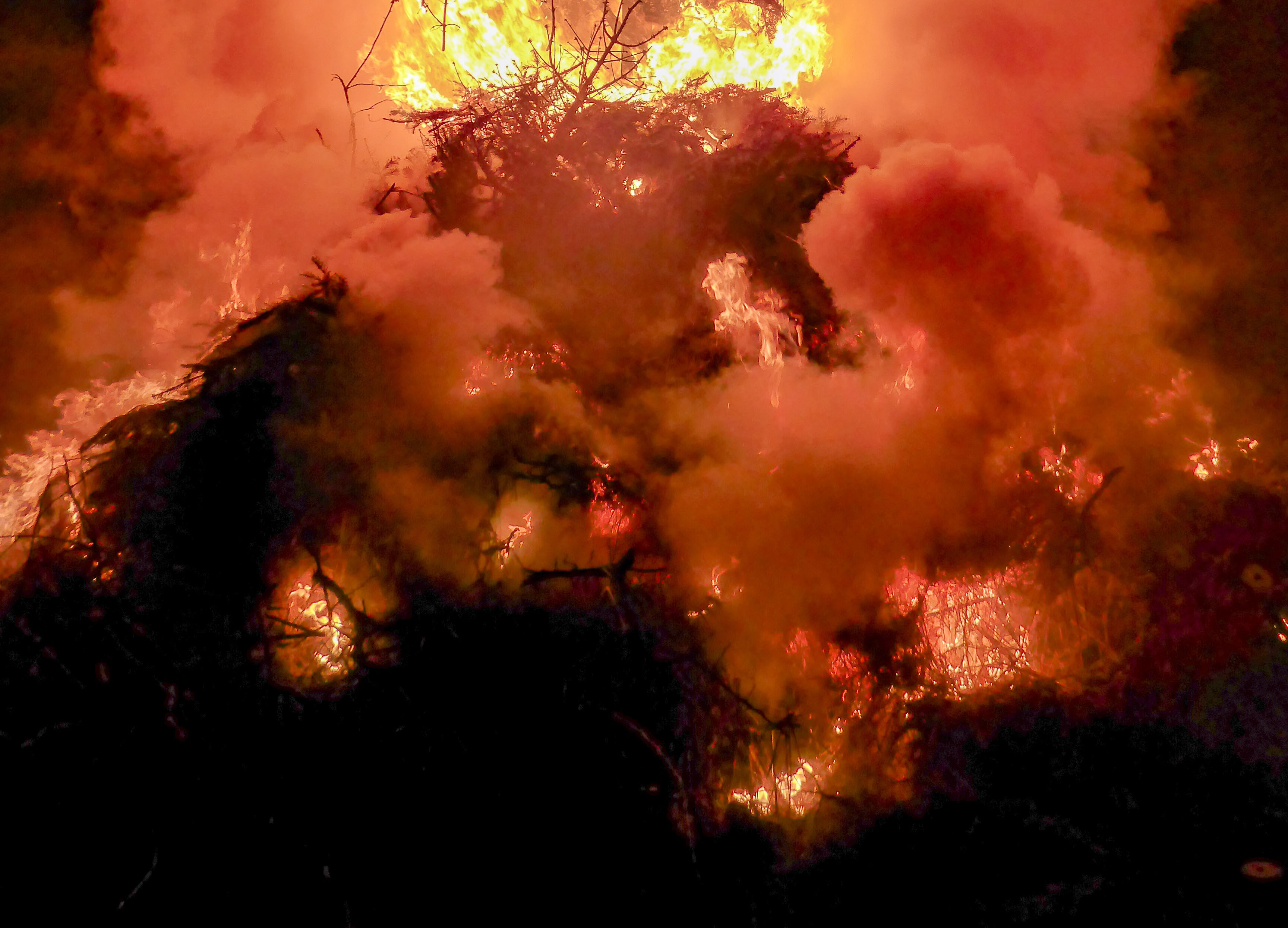 |
| As with the insect infestation (noted, above), the Bald Mountain Fire in 2018 September-October did not materially affect the painting, but made work on it that much more meaningful, at least for Al Young Studios. The wildfire eventually consisted of two lightning-caused blazes (the Pole Creek Fire and the Bald Mountain Fire) that merged to destroy 98,642 acres (19 square kilometers). Photo by Paul Keiffer. |
From 2018 October to May 2021 January, no work was done on the project. But from 2021 May to the following June, final glazing and treatment of the painting were completed.
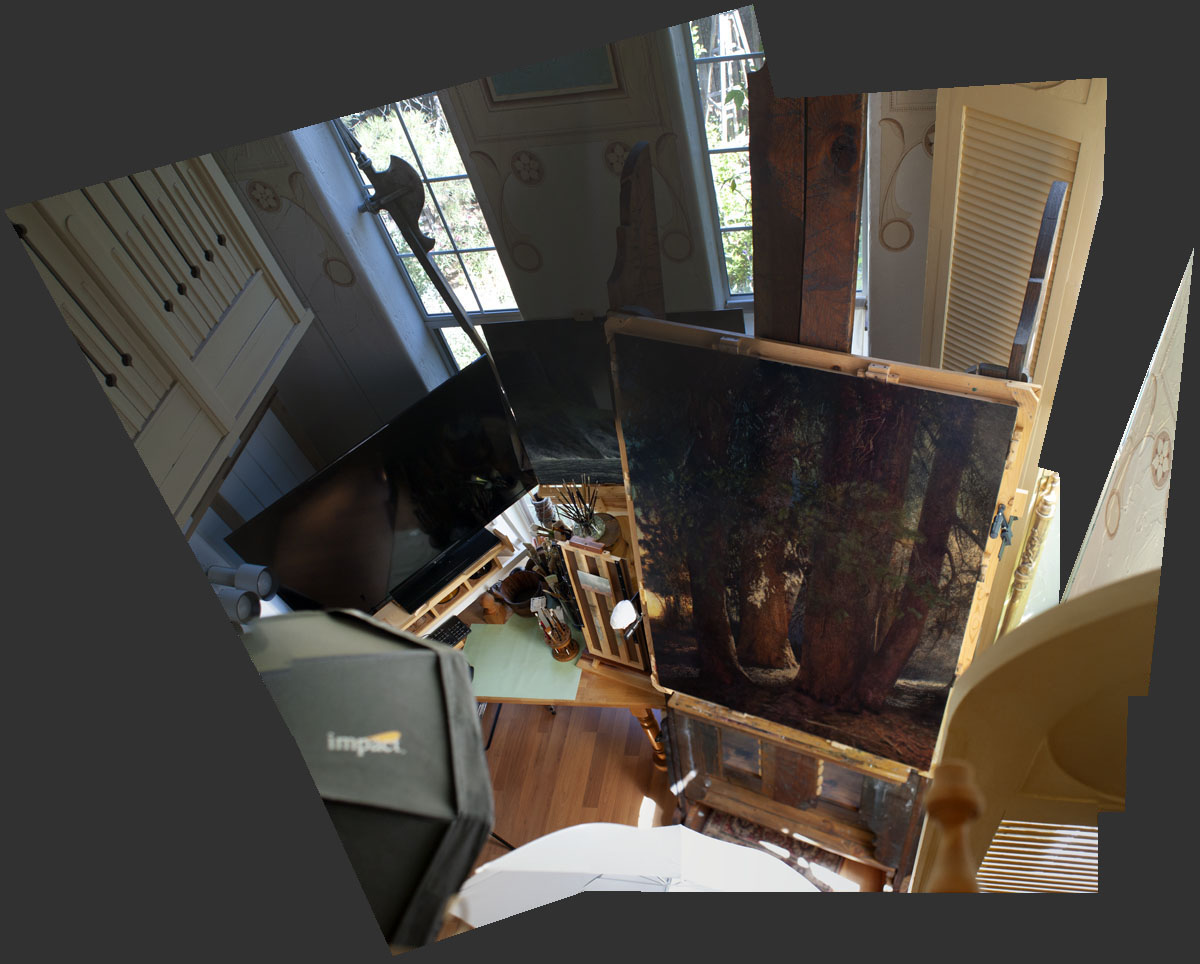 |
| Looking down on Trailhead, completed and resting on the easel. |
Tags: 3.00.0307.010, 2021, Project commentaries, Tips and techniques, Tools supplies and operations
Browse articles by year: 2025 . 2024 . 2023 . 2022 . 2021 . 2020 . 2019 . 2018 . 2017 . 2016 . 2015 . 2014 . 2013 . 2012 . 2011 . 2010 . 2009 . 2008 . 2007 . 2006 . 2005 . 2004 . 2003 . 2002 . 2001 . 2000 . 1999 . 1998 . 1997 . 1996
Browse articles by topic: Art lessons . BenHaven Archives . Blank art diaries . Fine art photography . Framing . Illustration . Inspiration and creativity . Isles of Rune . Limited Editions Collection . My Fathers Captivity . News . Novellas . Oil paintings and prints . Operations announcements . Orders and shipping . Overview . Portfolios . The Papers of Seymore Wainscott . Project commentaries . Recipes by Nancy Young . Recommended reading . Recommended viewing . Temple artworks . The Storybook Home Journal . Tips and techniques . Tools supplies and operations
Browse articles by topic: Art lessons . BenHaven Archives . Blank art diaries . Fine art photography . Framing . Illustration . Inspiration and creativity . Isles of Rune . Limited Editions Collection . My Fathers Captivity . News . Novellas . Oil paintings and prints . Operations announcements . Orders and shipping . Overview . Portfolios . The Papers of Seymore Wainscott . Project commentaries . Recipes by Nancy Young . Recommended reading . Recommended viewing . Temple artworks . The Storybook Home Journal . Tips and techniques . Tools supplies and operations